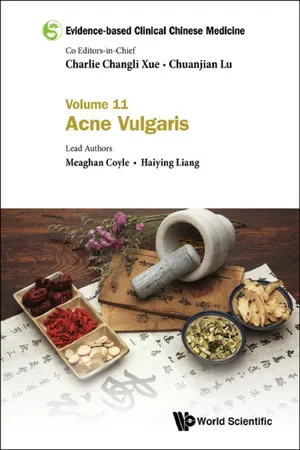
- 300 pages
- English
- ePUB (mobile friendly)
- Available on iOS & Android
About this book
The eleventh volume in the Evidence-based Clinical Chinese Medicine series is a must read for Chinese medicine practitioners interested in dermatology. Using a 'whole evidence' approach, this book aims to provide an analysis of the management of acne vulgaris with Chinese and integrative medicine.
This book describes the understanding and management of acne vulgaris with conventional medicine and Chinese medicine. Chinese medicine treatments used in past eras are analysed through data mining of classical Chinese medicine books. Several treatments are identified that are still used in contemporary clinical practice.
Attention is then turned to evaluating the current state of evidence from clinical studies using an evidence-based medicine approach. Scientific techniques are employed to evaluate the results from studies of Chinese herbal medicine, acupuncture and other Chinese medicine therapies. The findings from these reviews are discussed in terms of the implications for clinical practice and research.
Chinese medicine practitioners and students can use this book as a desktop reference to support clinical decision making. Having ready access to the current state of evidence for herbal formulas and acupuncture treatments allows practitioners to be confident in providing evidence-based health care.
This book provides an innovative 'whole evidence' approach to the management of acne vulgaris. Multiple types of evidence from different sources are reviewed and synthesized to provide a summary of the available evidence.
Interventions, including oral and topical Chinese herbal medicine, body and ear acupuncture and combinations of these therapies, are evaluated for their effect on acne lesion count and severity, and impact on health-related quality of life.
Chinese medicine treatments that have been frequently used in clinical studies provide guidance for patient care. This book links formulas, herbs and acupuncture points with treatment efficacy, providing the reader with potential for creating new formulas.
The editors of this series are internationally recognised, well-respected leaders in the field of Chinese medicine and evidence-based medicine with strong track records in research.
Contents:
- Introduction to Acne Vulgaris
- Acne Vulgaris in Chinese Medicine
- Classical Chinese Medicine Literature
- Methods for Evaluating Clinical Evidence
- Clinical Evidence for Chinese Herbal Medicine
- Pharmacological Actions of Frequently Used Herbs
- Clinical Evidence for Acupuncture and Related Therapies
- Clinical Evidence for Combination Therapies
- Summary and Conclusions
- Glossary
- Index
Readership: Chinese medicine practitioners and students.Chinese Medicine;Chinese Herbal Medicine;Acupuncture;Acne Vulgaris;Dermatology0 Key Features:
- A focus on the management of acne vulgaris with Chinese medicine comprising information from a vast array of resources. Much of the content is sourced from the Chinese literature, which is inaccessible to many practitioners
- The systematic evaluation of traditional and classical treatments provides historical background, context and origins of Chinese medical management of acne vulgaris, and draws parallels with contemporary practice
- Assessments of the evidence from clinical studies using scientific methods
- By providing this information in an easy to use reference, practitioners can focus on providing high quality care supported by the best available evidence
Frequently asked questions
- Essential is ideal for learners and professionals who enjoy exploring a wide range of subjects. Access the Essential Library with 800,000+ trusted titles and best-sellers across business, personal growth, and the humanities. Includes unlimited reading time and Standard Read Aloud voice.
- Complete: Perfect for advanced learners and researchers needing full, unrestricted access. Unlock 1.4M+ books across hundreds of subjects, including academic and specialized titles. The Complete Plan also includes advanced features like Premium Read Aloud and Research Assistant.
Please note we cannot support devices running on iOS 13 and Android 7 or earlier. Learn more about using the app.
Information
| Lesion Type | Subtype | Description |
| Comedonal | Closed (whitehead) | Small lesions containing keratin, sebum and bacteria, with barely visible follicular opening |
| Open (blackhead) | Small lesions containing keratin, sebum and bacteria, with visible follicular opening and mass of dark-coloured skin debris | |
| Papulopustular | Papules | Well-circumscribed inflammatory lesions with non-fluid filled swelling |
| Pustules | Inflammatory lesions containing visible purulent material | |
| Nodular | Nodules/cysts | Solid, raised, inflamed lesions varying in size and depth of tissue involvement |
Table of contents
- Cover
- Halftitle
- Title
- Copyright
- Disclaimer
- Foreword
- Purpose of This Book
- Authors and Contributors
- Members of Advisory Committee and Panel
- Professor Charlie Changli Xue
- Professor Chuanjian Lu
- Acknowledgments
- Contents
- List of Figures
- List of Tables
- 1. Introduction to Acne Vulgaris
- 2. Acne Vulgaris in Chinese Medicine
- 3. Classical Chinese Medicine Literature
- 4. Methods for Evaluating Clinical Evidence
- 5. Clinical Evidence for Chinese Herbal Medicine
- 6. Pharmacological Actions of Frequently Used Herbs
- 7. Clinical Evidence for Acupuncture and Related Therapies
- 8. Clinical Evidence for Combination Therapies
- 9. Summary and Conclusions
- Glossary
- Index